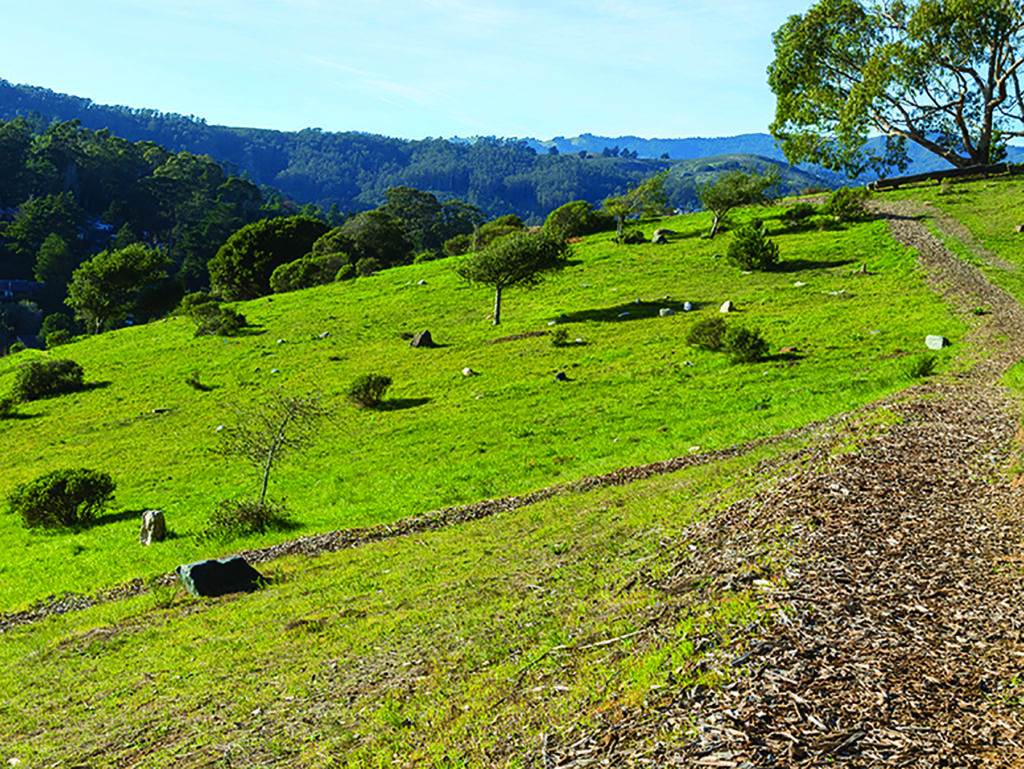Check Your Carbon
Footprint at the Door
BY COREY HILL
There is no shortage of great ideas for living green. Perhaps you walk instead of drive. You avoid throwing plastic bottle after plastic bottle into the refuse stream. You install solar panels on your roof, plant native shrubs in the front yard, and dig a compost garden in the back. But what about dying green? If you want to step into the next life with a minimal carbon footprint, some forethought is required. The impact of a traditional burial goes deeper than six feet. Here’s the breakdown:
Embalming:
To forestall the body’s decomposition, morticians employ chemicals such as formaldehyde, glutaraldehyde, methanol, and other solvents. The standard application is one gallon per 50 pounds of body weight. Multiply this amount by the number of deaths per year (2.8 million in the U.S.) and subtract the percentage of people who are buried vs. cremated (43%), and we are looking at north of 4 million gallons of solvent each year eventually leaching into the soil.
Caskets:
More than 500 million trees each year go to build caskets that are usually coated in a lacquer or veneer—all going straight into the earth. Metal caskets are no better. Add in the pesticides and petroleum required to maintain the grounds and plots and you’re looking at a substantial impact over time. What’s a body to do?
Cremation
is one option for reducing your footprint. No lumber, no embalming fluid, no groundwater contamination. In the last ten years, cremation surpassed traditional burial for the first time in the United States. The Bios Urn offers a more direct route for ashes to ashes—by creating a vessel that combines soil, cremated remains, and plant life. You die, you’re planted, you sprout into a bountiful tree.
Isabelle Bolla was one of the first customers when the Bios Urn launched in 2014. The experience impressed her so much that she began working there soon after. She has some good stories: “There was the one about wanting to be a crabapple tree on account of the person’s cantankerous personality … Lots of jokes about nut trees and wanting to throw shade from the great beyond to one-up haters—even in the afterlife.” One client requested being planted into a Christmas tree that the family decorates every year. The laws make it easy for family or friends to plant their Bios Urn on private property, but if you’re looking to sprout in a national forest you must first check in with the local park ranger.
Regular cremation saves carbon and methane emissions up front but remains imperfect. Cremation requires heating the body to 1,400-1,800 degrees for a sustained time, which contributes to global warming. Also most people don’t make it to the end of life carrying solely organic materials. During a standard cremation all non-organic materials such as silicone implants or metal fillings get released into the atmosphere.
Alkaline Hydrolysis:
Known alternately as water cremation, green cremation, or by the brand name Resumation, alkaline hydrolysis is a new technique that involves heat, water, a tiny volume of chemical, and pressure to render the human body into mere liquid and bone. This method is employed at the UCLA David Geffen School of Medicine’s Donated Body Program, whose program director, Dean R. Fisher, is an enthusiastic backer.
“With regard to carbon footprint, alkaline hydrolysis is about an eighth that of earth burial and about a fourth of standard cremation,” says Fisher. The liquid is returned to the water supply, a completely sterile reclamation of the water comprising more than 70% of our bodies. It’s dignified, it’s efficient, and it’s gaining more and more acceptance. It’s not legal everywhere, though. Currently 14 states allow it, including California, where Governor Jerry Brown was swayed in part by Fisher’s data.

Fernwood Cemetery, in Marin County, takes a wide-angle approach to end of life, allowing its clients to choose from a broad array of options. Though the cemetery opened in the late 1800s, it wasn’t until the current owner, Tyler Cassity, took over in the mid 2000s that Fernwood began introducing a nontraditional sustainable environmental approach to burial. Fernwood offers shrouds instead of caskets, and natural stone instead of concrete markers. The entire grounds are a celebrated wildlife habitat where the entirety of the memorial space is integrated into the landscape. It is a place where bikers and hikers pass through and where you’re just as likely to see native wildlife as mourners. The ethos centers around sustainability and situating death as a point in a cycle rather than something to be feared.
The burgeoning availability of sustainable end-of-life options is a promising development. The trend away from unnecessary chemicals and toward careful minimalist burial and cremation means millions will opt to make their final act a conscious choice to help pay forward a healthier planet. What could be greener than that?
Corey Hill is a Bay Area human rights activist, journalist, parent, and occasional tree climber.